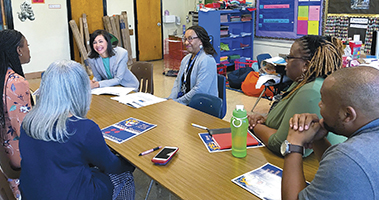
A Federal Commitment to Ending the ‘Homework Gap’
The new FCC chair outlines programs in place to support local schools and students’ online connectivity
BY JESSICA ROSENWORCEL/School Administrator, February 2022

|
| During Digital Inclusion Week 2019, Jessica Rosenworcel (far end of table) of the Federal Communications Commission gathered with Maryland-based educators to learn how they are integrating technology in the classroom. PHOTO COURTESY OF THE FEDERAL COMUNICATIONS COMMISSION |
Long before anyone had ever heard of COVID-19, superintendents, educators, and education advocates were speaking out about how it was unacceptable that millions of children in America were falling behind their classmates because they lacked the broadband access they need for nightly schoolwork.
For years, I’ve championed this cause at the Federal Communications Commission, calling this phenomenon the “Homework Gap” because it is the cruelest part of the digital divide.
But the pandemic was a game-changer for the Homework Gap. Virtually overnight, with no time to prepare, schools nationwide closed their doors and classrooms moved online. We went from having millions of children who couldn’t do online homework assignments to having millions of children who couldn’t do schoolwork at all. With millions locked out of the digital classroom, the Homework Gap be-came a full-fledged learning and education gap.
All across the country, we saw growing numbers of students stationed in parking lots outside schools, public libraries and fast-food restaurants trying to catch a free Wi-Fi signal so they could go online for class. These heartbreaking images were an all-too-familiar sight for educators, but we’d never witnessed them at this scale.
Scrambling for Access
The pandemic made apparent like nothing before that broadband is now essential. We need policies that make sure it reaches everyone, everywhere — students included.
Recognizing this,
school administrators across the country pulled out all the stops to get their students connected during the pandemic. Some sent Wi-Fi buses into their communities to give students a way to go online. Others worked with vendors, service providers and philanthropies and did whatever else they could think of to get students the internet access they needed. Their efforts were creative and often heroic, doing whatever they could to keep students connected, engaged and capable of spending time in the virtual classroom.
But educators shouldn’t have had to go at it alone because this is a national problem that deserves support on a national scale. And thanks to recent efforts in Washington, we now have programs to help address the Homework Gap in communities nationwide.
Discounted Broadband
The FCC has implemented the Emergency Broadband Benefit, our nation’s largest-ever program to help families afford internet service. The COVID-relief package adopted by Congress in December 2020 included $3.2 billion for the agency to establish this program to help more people get and stay connected during the pandemic.
As a result, eligible households now can receive discounts of up to $50 a month for broadband service or up to $75 a month if they reside on tribal lands. In some cases, participants also could receive a one-time, $100 discount on a computer or tablet. The FCC opened the Emergency Broadband Benefit Program to the public last May 12. In its first week, more than 1 million households signed up, proving beyond any doubt that too many households were struggling to afford to get online.
As of this past December, more than 8 million households had signed up for EBB support. That’s 8 million households, many with students, who might not otherwise be online.
Longer-Term Solutions
Congress took the next step to extend the largest-ever broadband affordability program and quadrupled its funding by establishing the Affordable Connectivity Program. Recognizing that broadband affordability was a problem before COVID-19 and would continue to be a challenge after the pandemic, the historic Infrastructure Investment and Jobs Act, which became law in November, included over $14 billion to extend the Emergency Broadband Benefit Program.
.jpg) |
| Jessica Rosenworcel addressed AASA’s National Conference on Education in February 2021 as the acting FCC chair. |
The new program will be called the Affordable Connectivity Program, and the more permanent subsidy going forward will be $30 a month for qualifying households. The monthly subsidy increases to $75 per month for households on tribal lands and in rural communities, where the price of internet access is usually higher. The program will continue to operate for several years until funding expires.
Meanwhile, Congress simultaneously created the largest-ever program to bring connectivity and devices to students through the Emergency Connectivity Fund. The American Rescue Plan, which became law last March, provided the FCC with $7.17 billion to help schools and libraries get people connected where they live. Just as the E-rate program has helped to connect schools, the Affordable Connectivity Program and Emergency Connectivity Fund help meet families’ connectivity and technology needs at home.
With this support, the FCC set up the Emergency Connectivity Fund, which reimburses schools and libraries for the purchase of laptop and tablet computers, Wi-Fi hotspots and other eligible equipment as well as broadband connections for students, school staff and library patrons. As of the end of 2021, we already have committed over $3 billion of this funding to school and library applicants, enough to sup-port connectivity for 10 million students. And there’s more on the way.
A National Priority
When you see multiple record-breaking investments to make sure everyone, everywhere is connected, it sends an unmistakable message that bridging the digital divide and erasing the Homework Gap are now top priorities in our nation’s capital. Thanks to these historic investments, I am hopeful that we will look back on this moment as the turning point that put us on the path to ensure no child is left offline.
JESSICA ROSENWORCEL is the chairwoman of the Federal Communications Commission in Washington, D.C. Twitter:
@JRosenworcelFCC